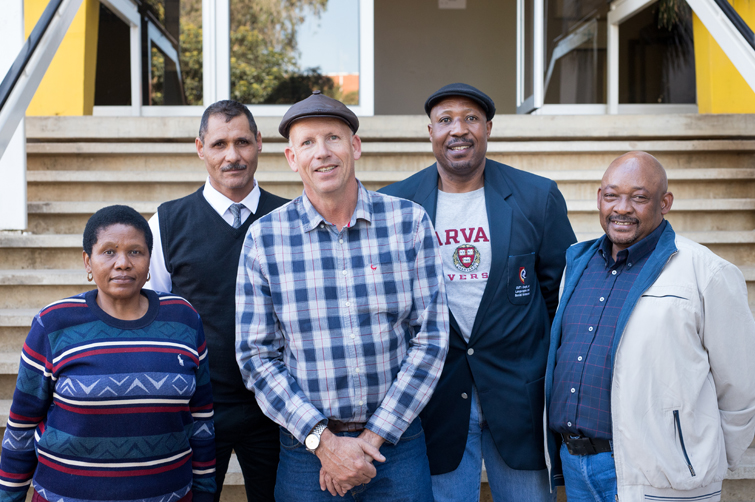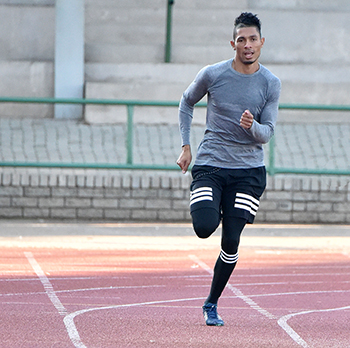Latest News Archive
Please select Category, Year, and then Month to display items
13 January 2020
|
Story Eugene Seegers
|
Photo Anja Aucamp
 Spearheading the digital expansion of the conversational Sesotho course is IDEAS Lab Director, Johann Möller (middle). With him are from the left: Prof Pule Phindane, CUT; Dr Brenton Fredericks, CUT; Bahedile Letlala, UFS Department of African Languages; and Dr Elias Malete, UFS Department of African Languages.
Spearheading the digital expansion of the conversational Sesotho course is IDEAS Lab Director, Johann Möller (middle). With him are from the left: Prof Pule Phindane, CUT; Dr Brenton Fredericks, CUT; Bahedile Letlala, UFS Department of African Languages; and Dr Elias Malete, UFS Department of African Languages.
For many years now, the UFS has been offering a one-year course in conversational Sesotho for staff members; this can then be followed up with the one-year course in advanced conversational Sesotho. The conversational Sesotho for students in the Faculty of Education was introduced in 2018 at the UFS.
The Central University of Technology (CUT) needed a conversational course for its first-year students and approached the Department of African Languages for the development of such a course. Living as we do in a multilingual country; this additional language skill opens doors and often hearts as well.
Using instructional design principles
However, the need was identified by both CUT and UFS to present this crucial information in a way that would be more appealing to digital natives as well as to those less familiar with technology. The Department of African Languages on the UFS Bloemfontein Campus, together with relevant departments from the CUT, approached the IDEAS Lab located on the UFS South Campus, since they already have a reputation for being a specialist on broadcasting and repackaging curricular content for digital presentations. The IDEAS Lab provided technical advice and built the multimedia programme, which will help the user to hear and practice phrases in Sesotho, using instructional design principles. The course will be available to both staff and students belonging to the two universities.
Room for growth
Johann Möller, Director of the IDEAS Lab, says this pilot programme will give both institutions the opportunity to test the use of multimedia for language acquisition. He adds, “Language is extremely complex, and we would like to expand this learning aid in the future.” In fact, the original design has room for growth built into it.
To keep things simple for the user and the building team, it was decided to start out with only four potential everyday scenarios where a staff member would like to speak Sesotho: Firstly, how to greet other persons from different genders; secondly, potential scenarios one might encounter in the university environment itself; thirdly, how to deal with situations at a hospital; and finally, how to use one’s language skills at a filling station.
Pronunciation is key
Each scenario contains three to four conversations that the learner can revise, along with images and audio that illustrate the situation and assist with correct pronunciation. The system does not allow the user to progress unless they have listened to the pronunciations of the sample sentences or phrases.
Further reading material and vocabulary lists are also provided, with the result that people who are using the programme can learn at their own pace. The authoring software Articulate Storyline was used to build the individual scenarios and each conversation or lesson within it. The lessons are also not dependent on an internet connection; they can be downloaded onto a flash memory drive and used offline.
Wayde runs 100 m personal best in Slovenia
2017-06-21

Wayde van Niekerk is in great form leading up to the
World Championships in London in August.
Photo: Charl Devenish
“This also bodes well for my two main distances." This is what Wayde van Niekerk said according to www.iaaf.org, after running a personal best time of 9.94 in the 100 m in Velenje, Slovenia, on 20 June 2017. The Kovsie athlete improved his previous best by 0.04 seconds at the 22nd International Athletics Meeting.
Van Niekerk was referring to the other distances in which he excels – the 200 m and 400 m. The 400 m world record-holder said he was pleased with his latest run: "It's my best time and I'm glad the competition ended the way I wanted it to.”
National 200 m record and world’s fastest in 2017
His feat in the 100 m was his latest success, as he recently became the national record-holder in the 200 m again, and also the fastest man on the planet in this distance in 2017. After he ran a 19.90, the world’s fastest this year, when he won the South African title in Potchefstroom in April, the American Christian Coleman (19.85) improved on that.
However, Van Niekerk ran a 19.84 in the 200 m at the Racers Grand Prix in Kingston, Jamaica, on 11 June 2017. This was 0.06 seconds quicker than his personal best, and 0.03 seconds better than Anaso Jobodwana’s national record of 19.87.
Same pace a second time in a week
It was also the second time in a week that he ran a 19.84 in the 200 m. This after he did it on a temporary built track at the Boost Boston Games on 4 June 2017. The race was run on a straight street course and was therefore not officially recognised as a record.
He seems to be in good shape leading up to his attempt to run a double, his favourite 400 m and the 200 m, at the World Championships in London, England, in August.